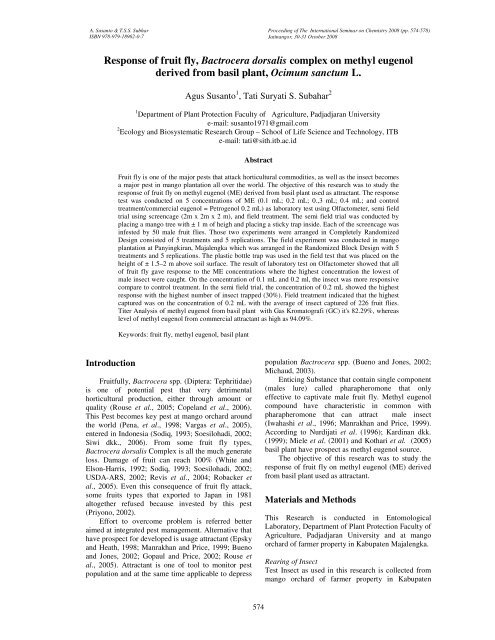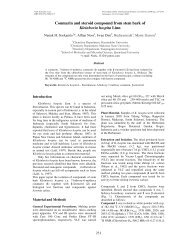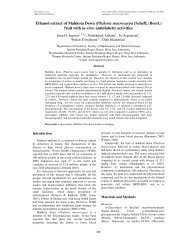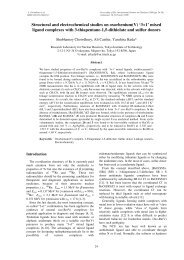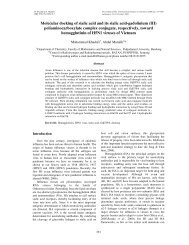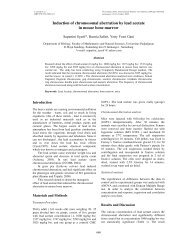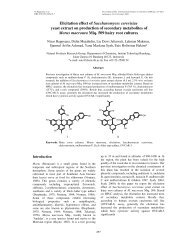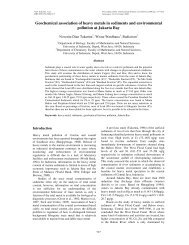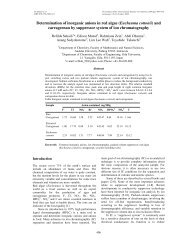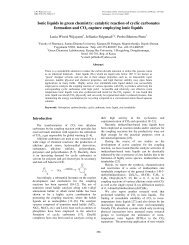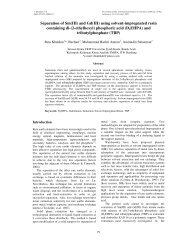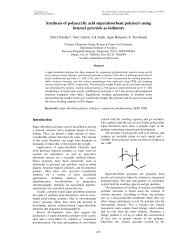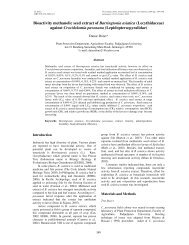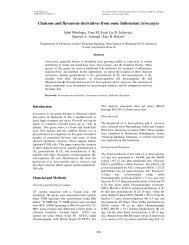Response of fruit fly, Bactrocera dorsalis complex on methyl eugenol ...
Response of fruit fly, Bactrocera dorsalis complex on methyl eugenol ...
Response of fruit fly, Bactrocera dorsalis complex on methyl eugenol ...
Create successful ePaper yourself
Turn your PDF publications into a flip-book with our unique Google optimized e-Paper software.
A. Susanto & T.S.S. Subhar Proceeding <str<strong>on</strong>g>of</str<strong>on</strong>g> The Internati<strong>on</strong>al Seminar <strong>on</strong> Chemistry 2008 (pp. 574-578)<br />
ISBN 978-979-18962-0-7<br />
Jatinangor, 30-31 October 2008<br />
<str<strong>on</strong>g>Resp<strong>on</strong>se</str<strong>on</strong>g> <str<strong>on</strong>g>of</str<strong>on</strong>g> <str<strong>on</strong>g>fruit</str<strong>on</strong>g> <str<strong>on</strong>g>fly</str<strong>on</strong>g>, <str<strong>on</strong>g>Bactrocera</str<strong>on</strong>g> <str<strong>on</strong>g>dorsalis</str<strong>on</strong>g> <str<strong>on</strong>g>complex</str<strong>on</strong>g> <strong>on</strong> <strong>methyl</strong> <strong>eugenol</strong><br />
derived from basil plant, Ocimum sanctum L.<br />
Agus Susanto 1 , Tati Suryati S. Subahar 2<br />
1 Department <str<strong>on</strong>g>of</str<strong>on</strong>g> Plant Protecti<strong>on</strong> Faculty <str<strong>on</strong>g>of</str<strong>on</strong>g> Agriculture, Padjadjaran University<br />
e-mail: susanto1971@gmail.com<br />
2 Ecology and Biosystematic Research Group – School <str<strong>on</strong>g>of</str<strong>on</strong>g> Life Science and Technology, ITB<br />
e-mail: tati@sith.itb.ac.id<br />
Abstract<br />
Fruit <str<strong>on</strong>g>fly</str<strong>on</strong>g> is <strong>on</strong>e <str<strong>on</strong>g>of</str<strong>on</strong>g> the major pests that attack horticultural commodities, as well as the insect becomes<br />
a major pest in mango plantati<strong>on</strong> all over the world. The objective <str<strong>on</strong>g>of</str<strong>on</strong>g> this research was to study the<br />
resp<strong>on</strong>se <str<strong>on</strong>g>of</str<strong>on</strong>g> <str<strong>on</strong>g>fruit</str<strong>on</strong>g> <str<strong>on</strong>g>fly</str<strong>on</strong>g> <strong>on</strong> <strong>methyl</strong> <strong>eugenol</strong> (ME) derived from basil plant used as attractant. The resp<strong>on</strong>se<br />
test was c<strong>on</strong>ducted <strong>on</strong> 5 c<strong>on</strong>centrati<strong>on</strong>s <str<strong>on</strong>g>of</str<strong>on</strong>g> ME (0.1 mL; 0.2 mL; 0.,3 mL; 0.4 mL; and c<strong>on</strong>trol<br />
treatment/commercial <strong>eugenol</strong> = Petrogenol 0.2 mL) as laboratory test using Olfactometer, semi field<br />
trial using screencage (2m x 2m x 2 m), and field treatment. The semi field trial was c<strong>on</strong>ducted by<br />
placing a mango tree with ± 1 m <str<strong>on</strong>g>of</str<strong>on</strong>g> heigh and placing a sticky trap inside. Each <str<strong>on</strong>g>of</str<strong>on</strong>g> the screencage was<br />
infested by 50 male <str<strong>on</strong>g>fruit</str<strong>on</strong>g> flies. Those two experiments were arranged in Completely Randomized<br />
Design c<strong>on</strong>sisted <str<strong>on</strong>g>of</str<strong>on</strong>g> 5 treatments and 5 replicati<strong>on</strong>s. The field experiment was c<strong>on</strong>ducted in mango<br />
plantati<strong>on</strong> at Panyingkiran, Majalengka which was arranged in the Randomized Block Design with 5<br />
treatments and 5 replicati<strong>on</strong>s. The plastic bottle trap was used in the field test that was placed <strong>on</strong> the<br />
height <str<strong>on</strong>g>of</str<strong>on</strong>g> ± 1.5–2 m above soil surface. The result <str<strong>on</strong>g>of</str<strong>on</strong>g> laboratory test <strong>on</strong> Olfactometer showed that all<br />
<str<strong>on</strong>g>of</str<strong>on</strong>g> <str<strong>on</strong>g>fruit</str<strong>on</strong>g> <str<strong>on</strong>g>fly</str<strong>on</strong>g> gave resp<strong>on</strong>se to the ME c<strong>on</strong>centrati<strong>on</strong>s where the highest c<strong>on</strong>centrati<strong>on</strong> the lowest <str<strong>on</strong>g>of</str<strong>on</strong>g><br />
male insect were caught. On the c<strong>on</strong>centrati<strong>on</strong> <str<strong>on</strong>g>of</str<strong>on</strong>g> 0.1 mL and 0.2 ml, the insect was more resp<strong>on</strong>sive<br />
compare to c<strong>on</strong>trol treatment. In the semi field trial, the c<strong>on</strong>centrati<strong>on</strong> <str<strong>on</strong>g>of</str<strong>on</strong>g> 0.2 mL showed the highest<br />
resp<strong>on</strong>se with the highest number <str<strong>on</strong>g>of</str<strong>on</strong>g> insect trapped (30%). Field treatment indicated that the highest<br />
captured was <strong>on</strong> the c<strong>on</strong>centrati<strong>on</strong> <str<strong>on</strong>g>of</str<strong>on</strong>g> 0.2 mL with the average <str<strong>on</strong>g>of</str<strong>on</strong>g> insect captured <str<strong>on</strong>g>of</str<strong>on</strong>g> 226 <str<strong>on</strong>g>fruit</str<strong>on</strong>g> flies.<br />
Titer Analysis <str<strong>on</strong>g>of</str<strong>on</strong>g> <strong>methyl</strong> <strong>eugenol</strong> from basil plant with Gas Kromatografi (GC) it's 82.29%, whereas<br />
level <str<strong>on</strong>g>of</str<strong>on</strong>g> <strong>methyl</strong> <strong>eugenol</strong> from commercial attractant as high as 94.09%.<br />
Keywords: <str<strong>on</strong>g>fruit</str<strong>on</strong>g> <str<strong>on</strong>g>fly</str<strong>on</strong>g>, <strong>methyl</strong> <strong>eugenol</strong>, basil plant<br />
Introducti<strong>on</strong><br />
Fruitfully, <str<strong>on</strong>g>Bactrocera</str<strong>on</strong>g> spp. (Diptera: Tephritidae)<br />
is <strong>on</strong>e <str<strong>on</strong>g>of</str<strong>on</strong>g> potential pest that very detrimental<br />
horticultural producti<strong>on</strong>, either through amount or<br />
quality (Rouse et al., 2005; Copeland et al., 2006).<br />
This Pest becomes key pest at mango orchard around<br />
the world (Pena, et al., 1998; Vargas et al., 2005),<br />
entered in Ind<strong>on</strong>esia (Sodiq, 1993; Soesilohadi, 2002;<br />
Siwi dkk., 2006). From some <str<strong>on</strong>g>fruit</str<strong>on</strong>g> <str<strong>on</strong>g>fly</str<strong>on</strong>g> types,<br />
<str<strong>on</strong>g>Bactrocera</str<strong>on</strong>g> <str<strong>on</strong>g>dorsalis</str<strong>on</strong>g> Complex is all the much generate<br />
loss. Damage <str<strong>on</strong>g>of</str<strong>on</strong>g> <str<strong>on</strong>g>fruit</str<strong>on</strong>g> can reach 100% (White and<br />
Els<strong>on</strong>-Harris, 1992; Sodiq, 1993; Soesilohadi, 2002;<br />
USDA-ARS, 2002; Revis et al., 2004; Robacker et<br />
al., 2005). Even this c<strong>on</strong>sequence <str<strong>on</strong>g>of</str<strong>on</strong>g> <str<strong>on</strong>g>fruit</str<strong>on</strong>g> <str<strong>on</strong>g>fly</str<strong>on</strong>g> attack,<br />
some <str<strong>on</strong>g>fruit</str<strong>on</strong>g>s types that exported to Japan in 1981<br />
altogether refused because invested by this pest<br />
(Priy<strong>on</strong>o, 2002).<br />
Effort to overcome problem is referred better<br />
aimed at integrated pest management. Alternative that<br />
have prospect for developed is usage attractant (Epsky<br />
and Heath, 1998; Manrakhan and Price, 1999; Bueno<br />
and J<strong>on</strong>es, 2002; Gopaul and Price, 2002; Rouse et<br />
al., 2005). Attractant is <strong>on</strong>e <str<strong>on</strong>g>of</str<strong>on</strong>g> tool to m<strong>on</strong>itor pest<br />
populati<strong>on</strong> and at the same time applicable to depress<br />
populati<strong>on</strong> <str<strong>on</strong>g>Bactrocera</str<strong>on</strong>g> spp. (Bueno and J<strong>on</strong>es, 2002;<br />
Michaud, 2003).<br />
Enticing Substance that c<strong>on</strong>tain single comp<strong>on</strong>ent<br />
(males lure) called pharapherom<strong>on</strong>e that <strong>on</strong>ly<br />
effective to captivate male <str<strong>on</strong>g>fruit</str<strong>on</strong>g> <str<strong>on</strong>g>fly</str<strong>on</strong>g>. Methyl <strong>eugenol</strong><br />
compound have characteristic in comm<strong>on</strong> with<br />
pharapherom<strong>on</strong>e that can attract male insect<br />
(Iwahashi et al., 1996; Manrakhan and Price, 1999).<br />
According to Nurdijati et al. (1996); Kardinan dkk.<br />
(1999); Miele et al. (2001) and Kothari et al. (2005)<br />
basil plant have prospect as <strong>methyl</strong> <strong>eugenol</strong> source.<br />
The objective <str<strong>on</strong>g>of</str<strong>on</strong>g> this research was to study the<br />
resp<strong>on</strong>se <str<strong>on</strong>g>of</str<strong>on</strong>g> <str<strong>on</strong>g>fruit</str<strong>on</strong>g> <str<strong>on</strong>g>fly</str<strong>on</strong>g> <strong>on</strong> <strong>methyl</strong> <strong>eugenol</strong> (ME) derived<br />
from basil plant used as attractant.<br />
Materials and Methods<br />
This Research is c<strong>on</strong>ducted in Entomological<br />
Laboratory, Department <str<strong>on</strong>g>of</str<strong>on</strong>g> Plant Protecti<strong>on</strong> Faculty <str<strong>on</strong>g>of</str<strong>on</strong>g><br />
Agriculture, Padjadjaran University and at mango<br />
orchard <str<strong>on</strong>g>of</str<strong>on</strong>g> farmer property in Kabupaten Majalengka.<br />
Rearing <str<strong>on</strong>g>of</str<strong>on</strong>g> Insect<br />
Test Insect as used in this research is collected from<br />
mango orchard <str<strong>on</strong>g>of</str<strong>on</strong>g> farmer property in Kabupaten<br />
574
A. Susanto & T.S.S. Subhar Proceeding <str<strong>on</strong>g>of</str<strong>on</strong>g> The Internati<strong>on</strong>al Seminar <strong>on</strong> Chemistry 2008 (pp. 574-578)<br />
Jatinangor, 30-31 October 2008<br />
Sumedang and Majalengka. Rearing <str<strong>on</strong>g>of</str<strong>on</strong>g> insect is<br />
c<strong>on</strong>ducted in. Entomological Laboratory, in<br />
temperature c<strong>on</strong>diti<strong>on</strong> 26 o C ± 2 o C and relative<br />
humidity 70-80 % and photoperiod 12 : 12.<br />
Preparing <str<strong>on</strong>g>of</str<strong>on</strong>g> Methyl Eugenol<br />
Basil Plant are got from area Tomo-Sumedang (to the<br />
aid POPT Tomo : Hikmat Sumantri). Methyl <strong>eugenol</strong><br />
is got from process <str<strong>on</strong>g>of</str<strong>on</strong>g> basil plant distillati<strong>on</strong>. Process<br />
<str<strong>on</strong>g>of</str<strong>on</strong>g> basil plant distillati<strong>on</strong> is began by prepare raw<br />
material have the shape <str<strong>on</strong>g>of</str<strong>on</strong>g> purple basil plant leaf that<br />
its age more than 3 m<strong>on</strong>th counted ± 5 kg, hereinafter<br />
leaf is referred run dry aerate during 2 till 3 day until<br />
wilt. Hereinafter raw material is entered into boiler <str<strong>on</strong>g>of</str<strong>on</strong>g><br />
water stuffed supplier ± 8 l. Process <str<strong>on</strong>g>of</str<strong>on</strong>g> basil plant<br />
distillati<strong>on</strong> takes place during ±5 hour, from raw<br />
material <str<strong>on</strong>g>of</str<strong>on</strong>g> 5 kg can produce distilled water counted<br />
±3 l and sweet basil oils between 5-30 ml.<br />
Fruit <str<strong>on</strong>g>fly</str<strong>on</strong>g> Testing to Methyl Eugenol<br />
The resp<strong>on</strong>se test was c<strong>on</strong>ducted <strong>on</strong> 5 c<strong>on</strong>centrati<strong>on</strong>s<br />
<str<strong>on</strong>g>of</str<strong>on</strong>g> ME (0.1 mL; 0.2 mL; 0.,3 mL; 0.4 mL; and c<strong>on</strong>trol<br />
treatment/commercial <strong>eugenol</strong> = Petrogenol 0.2 mL)<br />
as laboratory test using Olfactometer (Susanto and<br />
Kusumadewi, 2005), semi field trial using screencage<br />
(2m x 2m x 2 m) (Israely and Oman, 2005)., and field<br />
treatment. The semi field trial was c<strong>on</strong>ducted by<br />
placing a mango tree with ± 1 m <str<strong>on</strong>g>of</str<strong>on</strong>g> heigh and placing<br />
a sticky trap inside. Each <str<strong>on</strong>g>of</str<strong>on</strong>g> the screencage was<br />
infested by 50 male <str<strong>on</strong>g>fruit</str<strong>on</strong>g> flies. Those two experiments<br />
were arranged in Completely Randomized Design<br />
c<strong>on</strong>sisted <str<strong>on</strong>g>of</str<strong>on</strong>g> 5 treatments and 5 replicati<strong>on</strong>s. The field<br />
experiment was c<strong>on</strong>ducted in mango plantati<strong>on</strong> at<br />
Panyingkiran, Majalengka which was arranged in the<br />
Randomized Block Design with 5 treatments and 5<br />
replicati<strong>on</strong>s. The plastic bottle trap was used in the<br />
field test that was placed <strong>on</strong> the height <str<strong>on</strong>g>of</str<strong>on</strong>g> ± 1.5–2 m<br />
above soil surface (Papadopoulos et al., 2000; Peck et<br />
al., 2004).<br />
Testing <str<strong>on</strong>g>of</str<strong>on</strong>g> Methyl Eugenol Titer from Basil Plant<br />
Testing <str<strong>on</strong>g>of</str<strong>on</strong>g> level <str<strong>on</strong>g>of</str<strong>on</strong>g> <strong>methyl</strong> <strong>eugenol</strong> from basil plant<br />
c<strong>on</strong>ducted with Gas chromatography Analysis (GC)<br />
that c<strong>on</strong>ducted in Balitro Bogor with c<strong>on</strong>diti<strong>on</strong>:<br />
detector FID, column Silica capillary 30m, 0,25mm,<br />
carrier gas Helium, flow rate 1ml/minute, split ratio<br />
1/100, column temperature at program 60 – 200 o C<br />
with speed 3oC/minute, injector temperature 200 o C,<br />
detector temperature 250 o C and volume <str<strong>on</strong>g>of</str<strong>on</strong>g> inject<br />
0,2µl. Procedure in comm<strong>on</strong> c<strong>on</strong>ducted to analysis<br />
level <str<strong>on</strong>g>of</str<strong>on</strong>g> <strong>methyl</strong> <strong>eugenol</strong> that circulate in the<br />
commercial <strong>eugenol</strong> (Petrogenol).<br />
Results and Discussi<strong>on</strong><br />
Interest <str<strong>on</strong>g>of</str<strong>on</strong>g> male <str<strong>on</strong>g>fruit</str<strong>on</strong>g><str<strong>on</strong>g>fly</str<strong>on</strong>g> to Methyl Eugenol at<br />
Laboratory Scale<br />
Interest <str<strong>on</strong>g>of</str<strong>on</strong>g> male <str<strong>on</strong>g>fruit</str<strong>on</strong>g> <str<strong>on</strong>g>fly</str<strong>on</strong>g> to <strong>methyl</strong> <strong>eugenol</strong> at<br />
laboratory scale tested at Olfactometer. Test Result<br />
indicates that getting higher <strong>methyl</strong> c<strong>on</strong>centrati<strong>on</strong><br />
examinee <strong>eugenol</strong> growing low amount <str<strong>on</strong>g>of</str<strong>on</strong>g> male <str<strong>on</strong>g>fruit</str<strong>on</strong>g><br />
<str<strong>on</strong>g>fly</str<strong>on</strong>g> that interested (Picture 1). Though in statistic test<br />
not shows a marked difference. Male Fruit <str<strong>on</strong>g>fly</str<strong>on</strong>g> gave<br />
resp<strong>on</strong>s to all <strong>methyl</strong> <strong>eugenol</strong> c<strong>on</strong>centrati<strong>on</strong>s that<br />
tested. At c<strong>on</strong>centrati<strong>on</strong> 0.1 ml and 0.2 ml male <str<strong>on</strong>g>fruit</str<strong>on</strong>g><br />
<str<strong>on</strong>g>fly</str<strong>on</strong>g> that overdrawn high if compared to interest <str<strong>on</strong>g>of</str<strong>on</strong>g><br />
male <str<strong>on</strong>g>fruit</str<strong>on</strong>g> <str<strong>on</strong>g>fly</str<strong>on</strong>g> to <strong>methyl</strong> <strong>eugenol</strong> comparator.<br />
Methyl <strong>eugenol</strong> compound have characteristic in<br />
comm<strong>on</strong> with pharapherom<strong>on</strong>e that can attract male<br />
<str<strong>on</strong>g>fruit</str<strong>on</strong>g> <str<strong>on</strong>g>fly</str<strong>on</strong>g> (Manrakhan and Price, 1999). Methyl<br />
<strong>eugenol</strong> is c<strong>on</strong>sumed by male <str<strong>on</strong>g>fruit</str<strong>on</strong>g> <str<strong>on</strong>g>fly</str<strong>on</strong>g>, later, sintesed<br />
in its body produce sex pherom<strong>on</strong>e that to attract<br />
female <str<strong>on</strong>g>fruit</str<strong>on</strong>g> <str<strong>on</strong>g>fly</str<strong>on</strong>g> in course <str<strong>on</strong>g>of</str<strong>on</strong>g> matting (Nishida, 1996).<br />
Interest <str<strong>on</strong>g>of</str<strong>on</strong>g> Male Fruit <str<strong>on</strong>g>fly</str<strong>on</strong>g> to Methyl Eugenol at Screen<br />
cage Scale<br />
Interest <str<strong>on</strong>g>of</str<strong>on</strong>g> male <str<strong>on</strong>g>fruit</str<strong>on</strong>g> <str<strong>on</strong>g>fly</str<strong>on</strong>g> to <strong>methyl</strong> <strong>eugenol</strong> at semi<br />
scale natural tested at “outdoor screen cage”. Test<br />
Result indicates that at <strong>methyl</strong> <strong>eugenol</strong> c<strong>on</strong>centrati<strong>on</strong><br />
0.2 ml, amount <str<strong>on</strong>g>of</str<strong>on</strong>g> male <str<strong>on</strong>g>fruit</str<strong>on</strong>g> <str<strong>on</strong>g>fly</str<strong>on</strong>g> that interested show<br />
highest amount (30%) (Picture 2).<br />
30<br />
Jumlah Jantan Tertarik (%)<br />
25<br />
20<br />
15<br />
10<br />
5<br />
0<br />
0.1 mL 0.2 mL 0.3 mL 0.4 mL 0.2 mL (P)<br />
K<strong>on</strong>sentrasi ME<br />
Figure 1 Percentage <str<strong>on</strong>g>of</str<strong>on</strong>g> Male Fruit <str<strong>on</strong>g>fly</str<strong>on</strong>g> that interested to Methyl Eugenol at Laboratory Scale<br />
575
A. Susanto & T.S.S. Subhar Proceeding <str<strong>on</strong>g>of</str<strong>on</strong>g> The Internati<strong>on</strong>al Seminar <strong>on</strong> Chemistry 2008 (pp. 574-578)<br />
Jatinangor, 30-31 October 2008<br />
At semi c<strong>on</strong>diti<strong>on</strong> natural <str<strong>on</strong>g>fruit</str<strong>on</strong>g> <str<strong>on</strong>g>fly</str<strong>on</strong>g> interest to attractant<br />
influenced by ecological factor, like wind, irradiating,<br />
and temperature. Methyl <strong>eugenol</strong> is compound<br />
volatile and its way will growing resp<strong>on</strong>sed by <str<strong>on</strong>g>fruit</str<strong>on</strong>g><br />
<str<strong>on</strong>g>fly</str<strong>on</strong>g> at a distance <str<strong>on</strong>g>of</str<strong>on</strong>g> that growing far if helped by wind.<br />
Total <str<strong>on</strong>g>of</str<strong>on</strong>g> Male Fruit <str<strong>on</strong>g>fly</str<strong>on</strong>g> that Attract by Methyl Eugenol<br />
in the Field<br />
Testing <str<strong>on</strong>g>of</str<strong>on</strong>g> <str<strong>on</strong>g>fruit</str<strong>on</strong>g> <str<strong>on</strong>g>fly</str<strong>on</strong>g> interest field to <strong>methyl</strong> <strong>eugenol</strong> is<br />
c<strong>on</strong>ducted at mango orchard <str<strong>on</strong>g>of</str<strong>on</strong>g> farmer property in<br />
Panyingkiran, Majalengka. Highest caught is obtained<br />
at c<strong>on</strong>centrati<strong>on</strong> <str<strong>on</strong>g>of</str<strong>on</strong>g> basil plant oil 0.2 ml with the<br />
average <str<strong>on</strong>g>of</str<strong>on</strong>g> capture amount 226 tails.<br />
Utilizati<strong>on</strong> <str<strong>on</strong>g>of</str<strong>on</strong>g> attractant besides as the c<strong>on</strong>troller,<br />
also applicable to detect or m<strong>on</strong>itor <str<strong>on</strong>g>of</str<strong>on</strong>g> <str<strong>on</strong>g>fruit</str<strong>on</strong>g> <str<strong>on</strong>g>fly</str<strong>on</strong>g><br />
populati<strong>on</strong>, and c<strong>on</strong>fuse pattern <str<strong>on</strong>g>of</str<strong>on</strong>g> <str<strong>on</strong>g>fruit</str<strong>on</strong>g> <str<strong>on</strong>g>fly</str<strong>on</strong>g> matting,<br />
gather or behavior eats (Metcalf and Luckmann,<br />
1982; Bueno and J<strong>on</strong>es, 2002; Michaud, 2003).<br />
At this testing used trap <str<strong>on</strong>g>of</str<strong>on</strong>g> stuffed bottle with<br />
water 200 ml to kill <str<strong>on</strong>g>fruit</str<strong>on</strong>g> <str<strong>on</strong>g>fly</str<strong>on</strong>g> that caught. Mechanism<br />
trapping <str<strong>on</strong>g>of</str<strong>on</strong>g> B. <str<strong>on</strong>g>dorsalis</str<strong>on</strong>g> into trap seen that B. <str<strong>on</strong>g>dorsalis</str<strong>on</strong>g><br />
that come into trap will directly <str<strong>on</strong>g>fly</str<strong>on</strong>g> and alight <strong>on</strong> to<br />
cott<strong>on</strong> surface that has been dropped attractant. B.<br />
<str<strong>on</strong>g>dorsalis</str<strong>on</strong>g> are referred hereinafter will walk al<strong>on</strong>g<br />
encircle cott<strong>on</strong> with time period that is not certain. In<br />
a little while B. <str<strong>on</strong>g>dorsalis</str<strong>on</strong>g> are referred flew circulate<br />
and try descend up<strong>on</strong> wall <str<strong>on</strong>g>of</str<strong>on</strong>g> trap interior (Kardinan<br />
dkk., 1999).<br />
Attractant have the materials <str<strong>on</strong>g>of</str<strong>on</strong>g> active <strong>methyl</strong><br />
<strong>eugenol</strong> this is pertained to ”food lure” that means<br />
male <str<strong>on</strong>g>fly</str<strong>on</strong>g> will come interested for eat, not for sexual<br />
directly.<br />
Male will make every effort to get <strong>methyl</strong><br />
<strong>eugenol</strong> before c<strong>on</strong>duct matting. From characteristic<br />
<str<strong>on</strong>g>of</str<strong>on</strong>g> attractant this is <str<strong>on</strong>g>fruit</str<strong>on</strong>g> <str<strong>on</strong>g>fly</str<strong>on</strong>g> operati<strong>on</strong> is c<strong>on</strong>ducted by<br />
depress populati<strong>on</strong> <str<strong>on</strong>g>of</str<strong>on</strong>g> male <str<strong>on</strong>g>fly</str<strong>on</strong>g>, until expected al<strong>on</strong>g<br />
with time <str<strong>on</strong>g>of</str<strong>on</strong>g> <str<strong>on</strong>g>fruit</str<strong>on</strong>g> <str<strong>on</strong>g>fly</str<strong>on</strong>g> populati<strong>on</strong> in nature will be<br />
downhill, because female not can matting.<br />
Titer <str<strong>on</strong>g>of</str<strong>on</strong>g> Methyl Eugenol from Basil Plant<br />
Analysis <str<strong>on</strong>g>of</str<strong>on</strong>g> titer level <str<strong>on</strong>g>of</str<strong>on</strong>g> <strong>methyl</strong> <strong>eugenol</strong> from oil <str<strong>on</strong>g>of</str<strong>on</strong>g><br />
distillate basil plant c<strong>on</strong>ducted with Gas<br />
chromatography (GC) that c<strong>on</strong>ducted in Balitro<br />
Bogor. Analysis Result like can be seen at Table 1.<br />
35<br />
Jumlah Jantan Tertarik (%)<br />
30<br />
25<br />
20<br />
15<br />
10<br />
5<br />
0<br />
0.1 mL 0.2 mL 0.3 mL 0.4 mL 0.2 mL (P)<br />
K<strong>on</strong>sentrasi ME<br />
Figure 2 Percentage <str<strong>on</strong>g>of</str<strong>on</strong>g> Male Fruit <str<strong>on</strong>g>fly</str<strong>on</strong>g> that interested to Methyl Eugenol at Screen cage Scale<br />
250<br />
Jumlah Tangkapan (ekor)<br />
200<br />
150<br />
100<br />
50<br />
0<br />
0.1 mL 0.2 mL 0.3 mL 0.4 mL 0.2 mL (P)<br />
K<strong>on</strong>sentrasi ME<br />
Figure 3 Total <str<strong>on</strong>g>of</str<strong>on</strong>g> Male Fruit <str<strong>on</strong>g>fly</str<strong>on</strong>g> Caught in the Filed<br />
576
A. Susanto & T.S.S. Subhar Proceeding <str<strong>on</strong>g>of</str<strong>on</strong>g> The Internati<strong>on</strong>al Seminar <strong>on</strong> Chemistry 2008 (pp. 574-578)<br />
Jatinangor, 30-31 October 2008<br />
Tables 1 Result <str<strong>on</strong>g>of</str<strong>on</strong>g> Analysis Methyl Eugenol Titer<br />
Compound Titer <str<strong>on</strong>g>of</str<strong>on</strong>g> Methyl Eugenol (%)<br />
Oil <str<strong>on</strong>g>of</str<strong>on</strong>g> Basil Plant 82.29<br />
Commercial ME (Petrogenol) 94.09<br />
Analysis Result shows titer <str<strong>on</strong>g>of</str<strong>on</strong>g> <strong>methyl</strong> <strong>eugenol</strong><br />
from basil plant below titer <str<strong>on</strong>g>of</str<strong>on</strong>g> commercial <strong>methyl</strong><br />
<strong>eugenol</strong> (Petrogenol). Though titer <str<strong>on</strong>g>of</str<strong>on</strong>g> <strong>methyl</strong> <strong>eugenol</strong><br />
from basil plant, field test indicates that <str<strong>on</strong>g>fruit</str<strong>on</strong>g> <str<strong>on</strong>g>fly</str<strong>on</strong>g> haul<br />
that caught at sweet basil c<strong>on</strong>centrati<strong>on</strong> 0.2 ml higher<br />
if compared to c<strong>on</strong>centrati<strong>on</strong> in comm<strong>on</strong> at attractant<br />
comparator. This c<strong>on</strong>diti<strong>on</strong> indicated that sweet basil<br />
have high prospect for developed as the source <str<strong>on</strong>g>of</str<strong>on</strong>g><br />
natural attractant. This c<strong>on</strong>diti<strong>on</strong> are supported by<br />
former research that indicate that basil plant have<br />
prospect as attractant source (Nurdijati et al., 1996;<br />
Kardinan dkk., 1999; Mielle et al., 2001 and Kothari<br />
et al., 2005).<br />
C<strong>on</strong>clusi<strong>on</strong>s<br />
The result <str<strong>on</strong>g>of</str<strong>on</strong>g> laboratory test <strong>on</strong> Olfactometer showed<br />
that all <str<strong>on</strong>g>of</str<strong>on</strong>g> <str<strong>on</strong>g>fruit</str<strong>on</strong>g> <str<strong>on</strong>g>fly</str<strong>on</strong>g> gave resp<strong>on</strong>se to the ME<br />
c<strong>on</strong>centrati<strong>on</strong>s where the highest c<strong>on</strong>centrati<strong>on</strong> the<br />
lowest <str<strong>on</strong>g>of</str<strong>on</strong>g> male insect were caught. On the<br />
c<strong>on</strong>centrati<strong>on</strong> <str<strong>on</strong>g>of</str<strong>on</strong>g> 0.1 mL and 0.2 ml, the insect was<br />
more resp<strong>on</strong>sive compare to c<strong>on</strong>trol treatment. In the<br />
semi field trial, the c<strong>on</strong>centrati<strong>on</strong> <str<strong>on</strong>g>of</str<strong>on</strong>g> 0.2 mL showed<br />
the highest resp<strong>on</strong>se with the highest number <str<strong>on</strong>g>of</str<strong>on</strong>g> insect<br />
trapped (30%). Field treatment indicated that the<br />
highest captured was <strong>on</strong> the c<strong>on</strong>centrati<strong>on</strong> <str<strong>on</strong>g>of</str<strong>on</strong>g> 0.2 mL<br />
with the average <str<strong>on</strong>g>of</str<strong>on</strong>g> insect captured <str<strong>on</strong>g>of</str<strong>on</strong>g> 226 <str<strong>on</strong>g>fruit</str<strong>on</strong>g> flies.<br />
Titer Analysis <str<strong>on</strong>g>of</str<strong>on</strong>g> <strong>methyl</strong> <strong>eugenol</strong> from basil plant<br />
with Gas Kromatografi (GC) it's 82.29%, whereas<br />
level <str<strong>on</strong>g>of</str<strong>on</strong>g> <strong>methyl</strong> <strong>eugenol</strong> from commercial attractant as<br />
high as 94.09%.<br />
References<br />
Bueno AM. and O. J<strong>on</strong>es. 2002. Alternative Methods<br />
for C<strong>on</strong>trolling the Olive Fly, <str<strong>on</strong>g>Bactrocera</str<strong>on</strong>g> oleae,<br />
Involving Semiochemical. 2002. IOBC wprs<br />
Bulletin. Vol. 25 : 1-11 (2002).<br />
Copeland RS., RA. Whart<strong>on</strong>, Q. Luke, MD. Meyer, S.<br />
Lux, N. Zenz, P. Machera and M. Okumu. 2006.<br />
Geographic Distributi<strong>on</strong>, Host Fruit, and<br />
Parasitoids <str<strong>on</strong>g>of</str<strong>on</strong>g> African Fruit Fly Pest Ceratitis<br />
an<strong>on</strong>ae, Ceratitis cosyra, Ceratitis fasciventris,<br />
and Ceratitis rosa (Diptera : Tephritidae) in<br />
Kenya. Ann. Entomol. Soc. Am. 99(2) : 261-278<br />
(2006).<br />
Epsky ND. and RR. Heath. 1998. Exploting the<br />
Interacti<strong>on</strong>s <str<strong>on</strong>g>of</str<strong>on</strong>g> Chemical and Visual Cues in<br />
Behavioral C<strong>on</strong>trol Measures for Pest Tephritid<br />
Fruit Flies. Florida Entomologist. 81(3) : 273-282<br />
(1998).<br />
Gopaul S. and NS. Price. 2002. Local Producti<strong>on</strong> <str<strong>on</strong>g>of</str<strong>on</strong>g><br />
Protein Bait for Use in Fruit Fly M<strong>on</strong>itoring and<br />
C<strong>on</strong>trol. Indian Ocean Regi<strong>on</strong>al Fruit Fly<br />
Programme.<br />
Israely N. and SD. Oman. 2005. Effect <str<strong>on</strong>g>of</str<strong>on</strong>g> Combined<br />
Insecticide Sprays and Sanitati<strong>on</strong> Techniques <strong>on</strong><br />
Populati<strong>on</strong> Dynamics <str<strong>on</strong>g>of</str<strong>on</strong>g> Ceratitis capitata<br />
(Diptera: Tephritidae) in the Central Mountains<br />
<str<strong>on</strong>g>of</str<strong>on</strong>g> Israel.. J. Ec<strong>on</strong>. Entomol. 98(3) : 793-748<br />
(2005).<br />
Iwahashi, O., S. Sastrodihardjo and T.S. Subahar.<br />
1996. The Mysteri <str<strong>on</strong>g>of</str<strong>on</strong>g> Methyl Eugenol: 1. Why<br />
Methyl Eugenol is so Effective for C<strong>on</strong>trolling<br />
Fruit Flies? Presented in XIX Internati<strong>on</strong>al<br />
C<strong>on</strong>gress <str<strong>on</strong>g>of</str<strong>on</strong>g> Entomology, Firenze-Italy.<br />
Kardinan, A., M. Iskandar, S. Rusli, dan Makmun.<br />
1999. Potensi Daun Selasih (Ocimum sanctum)<br />
sebagai Atraktan Nabati untuk Pengendali Hama<br />
Lalat Buah <str<strong>on</strong>g>Bactrocera</str<strong>on</strong>g> <str<strong>on</strong>g>dorsalis</str<strong>on</strong>g>. Makalah Forum<br />
Komunikasi Ilmiah Pemanfaatan Pestisida<br />
Nabati. Balai Penelitian Tanaman Rempah dan<br />
Obat. Bogor, 9-10 November 1999.<br />
Kothari, S K, Bhattacharya, A K, Ramesh, S, Garg,<br />
S N, Khanuja, S P S. 2005. Volatile C<strong>on</strong>stituents<br />
in Oil from Different Plant Parts <str<strong>on</strong>g>of</str<strong>on</strong>g> Methyl<br />
Eugenol-Rich Ocimum tenuiflorum L.f. (syn. O.<br />
sanctum L.) Grown in South India. Journal <str<strong>on</strong>g>of</str<strong>on</strong>g><br />
Essential Oil Research: JEOR, Nov/Dec 2005.<br />
Manrakhan A., and NS. Price. 1999. Seas<strong>on</strong>al Pr<str<strong>on</strong>g>of</str<strong>on</strong>g>iles<br />
in Producti<strong>on</strong>, Fruit Fly Populati<strong>on</strong>s and Fly<br />
Damage <strong>on</strong> Mangoes in Mauratius. AMAS, Food<br />
and Agriculture Research Council, Reduit,<br />
Mauratius. 107-115.<br />
Metcalf, R.L. & H.L. William. 1982. Introducti<strong>on</strong> To<br />
Insect Pest Management. John Willey & S<strong>on</strong>s.<br />
New York, Pp :175-216.<br />
Michaud, JP. 2003. Toxicity <str<strong>on</strong>g>of</str<strong>on</strong>g> Fruit Fly Baits to<br />
Beneficial Insects in Citrus. J. <str<strong>on</strong>g>of</str<strong>on</strong>g> Insect Science.<br />
Available <strong>on</strong>line : insectscience.org/3.8.<br />
Miele M., R. D<strong>on</strong>dero, G. Ciarallo and M. Mazzei.<br />
2001. Methyl<strong>eugenol</strong> in Ocimum basilicum L.<br />
Cv. Genovese Gigante. J. Agric. Food Chem.<br />
49(1): 517-521 (2001).<br />
Nishida, R. 1996. Pherom<strong>on</strong>al Communicati<strong>on</strong><br />
in the Oriental Fruit Moth and Oriental Fruit Fly.<br />
Proc. Int. Symp. Insect Pest C<strong>on</strong>trol With<br />
Pherom<strong>on</strong>es. Oct 18 – 19, 1996. pp. 102 – 113.<br />
Nurdijati S, KH Tan and YC To<strong>on</strong>g, 1996. Basil Plant<br />
(Ocimum spp.) and Their Prospect in the<br />
Management <str<strong>on</strong>g>of</str<strong>on</strong>g> Fruit Flies. Proceedings <str<strong>on</strong>g>of</str<strong>on</strong>g> the<br />
Sec<strong>on</strong>d Symposium <strong>on</strong> Tropical Fruit Fllies<br />
1995, Kuala Lumpur Malaysia.<br />
Papadopoulos NT., Katsoyannos BI. And JR. Carey,<br />
2000. Spring and Early Summer Phenology and<br />
Detecti<strong>on</strong> <str<strong>on</strong>g>of</str<strong>on</strong>g> Ceratitis capitata<br />
577
A. Susanto & T.S.S. Subhar Proceeding <str<strong>on</strong>g>of</str<strong>on</strong>g> The Internati<strong>on</strong>al Seminar <strong>on</strong> Chemistry 2008 (pp. 574-578)<br />
Jatinangor, 30-31 October 2008<br />
(Diptera : Tephritidae) in Northern Greece. In Tan<br />
KH. : Area-Wide C<strong>on</strong>trol <str<strong>on</strong>g>of</str<strong>on</strong>g> Fruit Flies and Other<br />
Insect Pests. Penerbit Universiti Sains Malaysia,<br />
2000. pp 583 – 590.<br />
Peck SL. and GT. McQuate, 2004. Ecological Aspect<br />
<str<strong>on</strong>g>of</str<strong>on</strong>g> <str<strong>on</strong>g>Bactrocera</str<strong>on</strong>g> latifr<strong>on</strong>s (Diptera : Tephritidae)<br />
<strong>on</strong> Maui, Hawaii : Movement and Host<br />
Preference. J. Envir<strong>on</strong>. Entomol. 33 (6) : 1722 –<br />
1731.<br />
Pena JE., AI. Mohyoudin and M. Wysoki. 1998. A<br />
Review <str<strong>on</strong>g>of</str<strong>on</strong>g> the Pest Management Situati<strong>on</strong> in<br />
Mango Agroecosystems. J. Phytoparasitica. 26(2)<br />
: 1-20 (1998).<br />
Priy<strong>on</strong>o, J. 2002. Pengembangan Peramalan Lalat<br />
Buah, <str<strong>on</strong>g>Bactrocera</str<strong>on</strong>g> spp. Di Tingkat Wilayah, Balai<br />
Peramalan Organisme Pengganggu Tumbuhan,<br />
Jatisari.<br />
Revis HC., NW. Miller and RI. Vargas. 2004. Effects<br />
<str<strong>on</strong>g>of</str<strong>on</strong>g> Aging Diluti<strong>on</strong> <strong>on</strong> Attracti<strong>on</strong> and Toxicyti og<br />
GF-120 Fruit Fly Bait Spray for Mel<strong>on</strong> Fly<br />
C<strong>on</strong>trol in Hawaii. J. Ec<strong>on</strong>. Entomol. 97(5) :<br />
1659-1665 (2004).<br />
Robacker D.C. and D. Czokajlo. 2005. Efficacy <str<strong>on</strong>g>of</str<strong>on</strong>g><br />
Two Synthetic Food-Odor Lures for Mexican<br />
Fruit flies (Diptera : Tephritidae) Is Determined<br />
by Trap Type. 2005. J. Ec<strong>on</strong>. Entomol. 98(5):<br />
1517-1523 (2005).<br />
Rouse P., PF. Duyck, S. Quilici and P. Ryckewaert.<br />
2005. Adjustment <str<strong>on</strong>g>of</str<strong>on</strong>g> Field Cage Methodology for<br />
Testing Food Attractants for Friut Flies (Diptera :<br />
Tephritidae). Ann. Entomol. Soc. Am. 98(3) :<br />
402-408 (2005).<br />
Siwi SS., P. Hidayat, dan Suputa, 2006. Taks<strong>on</strong>omi<br />
dan Bioekologi Lalat Buah Penting, <str<strong>on</strong>g>Bactrocera</str<strong>on</strong>g><br />
spp. (Diptera : Tephritidae) di Ind<strong>on</strong>esia. Balai<br />
Besar Penelitian dan Pengembangan<br />
Bioteknologi dan Sumberdaya Genetik, Bogor.<br />
Sodiq, M. 1993. Aspek Biologi dan Sebaran Populasi<br />
Lalat Buah Pada Tanaman Mangga dalam Kaitan<br />
dengan Pengembangan Model Pengendalian<br />
Hama Terpadu. Disertasi, Program Pascasarjana<br />
Universitas Airlangga.<br />
Susanto A. dan V. Kusumadewi. 2005. Repelensi<br />
Minyak Atsiri Asal Tanaman Nilam, Bawang<br />
Putih, Lavender dan Akar Wangi Terhadap<br />
Tribolium castaneum Herbst. (Coleoptera :<br />
Tenebri<strong>on</strong>idae) di Laboratorium. Agrikultura 16<br />
(1) : 60-66, 2005<br />
Soesilohadi, RCH, 2002. Dinamika Populasi Lalat<br />
Buah, <str<strong>on</strong>g>Bactrocera</str<strong>on</strong>g> carambolae Drew and<br />
Handcock (Diptera : Tephritidae). Disertasi,<br />
Program Pascasarjana, ITB.<br />
USDA – ARS, 2002 ORIENTAL FRUIT FLY<br />
(<str<strong>on</strong>g>Bactrocera</str<strong>on</strong>g> <str<strong>on</strong>g>dorsalis</str<strong>on</strong>g> (Hendel)).<br />
http://www.paci<str<strong>on</strong>g>fly</str<strong>on</strong>g>.org/Species_pr<str<strong>on</strong>g>of</str<strong>on</strong>g>iles/B_dorsal<br />
is.htm. Diakses 13 September 2005<br />
Vargas RI., JD. Stark, B. Mackey and R. Bull. 2005.<br />
Weathering Trials <str<strong>on</strong>g>of</str<strong>on</strong>g> Amulet Cue-Lure and<br />
Amulet Methyl Eugenol “Attract-and-Kill”<br />
Stati<strong>on</strong>s with Male Mel<strong>on</strong> Flies and Oriental<br />
Fruit Flies (Diptera:tephritidae) in Hawai. J.<br />
Ec<strong>on</strong>. Entomol. 98(5) 1551-1559 (2005).<br />
White IM and MM Els<strong>on</strong>-Harris, 1992. Fruit Flies <str<strong>on</strong>g>of</str<strong>on</strong>g><br />
Ec<strong>on</strong>omic Significance: Their Identificati<strong>on</strong> and<br />
Bi<strong>on</strong>omics. CABI and ACIAR, UK.<br />
578


